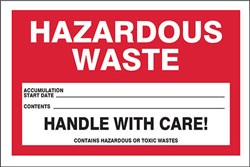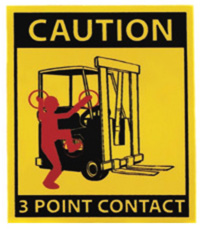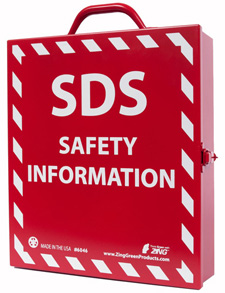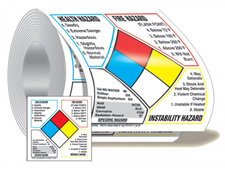| The Home page of ILPI's Safety Data Sheet (SDS) Resource, the leader in SDS information since 1995! | |
| The history and philosophy behind this resource. | |
| A curated collection of books and reference materials concerning Safety Data Sheets and closely related topics. | |
| Paste your plain text SDS into the SDS-Demystifier, and it will be converted into a hypertext-enriched document with links to detailed explanations of each key term. | |
| An extensive list of frequently asked questions about Safety Data Sheets including regulations, content, compliance, and more. | |
| A humorous take on Safety Data Sheet jargon. Fill in the blanks on our entry form to generate a personalized Unsafety Data Sheet to share with your coworkers. | |
| Since 1995, we've maintained this massive curated list of the best places to find Safety Data Sheets on the Internet. | |
| You are here! Way more than a glossary, this hypertext-enhanced resource covers hundreds of SDS-related terms and expert knowledge. Each entry includes both the SDS relevance and links to additional authoritative resources. | |
| Archived results of Safety Data Sheet related polls taken by some of our millions of site visitors | |
| The OSHA regulations behind SDS regulations, including the inspection guidelines and over 400 official interpretations letters under the Hazard Communication Standard | |
| Commercial suppliers of SDS authoring and management software as well as cloud compliance services. | |
| Commercial companies that will create SDS's for your specific needs as well as SDS translation companies. |

Safety signs, banners, and scoreboards? Get yours at Safety Emporium!
Definition

Get your hazardous waste labels from Safety Emporium.
The U.S. OSHA Hazardous Waste Operations and Emergency Response, HAZWOPER standards, 29 CFR 1910.120 (for general industry) and 29 CFR 1926.65 (for construction), regulate the safety and health of the employees involved in clean-up operations at uncontrolled hazardous waste sites, employees engaged in certain hazardous waste sites, employees engaged in certain hazardous waste treatment, storage, and disposal (TSD) operations, and in any emergency response activities involving hazardous substances. In short, HAZWOPER applies to hazardous waste facilities.
The two standards, 29 CFR 1910.120 and 29 CFR 1926.55, are identical. In addition, the US EPA has its own identical standard, 40 CFR 311, which incorporates 29 CFR 1910.120 by reference. Therefore, most professionals simply refer to HAZWOPER as 29 CFR 1910.120 when citing the regulation.
Additional Info
EPA vs OSHA HAZWOPER
Federal OSHA does not cover state and local government employees. However, when OSHA was created in 1970, Congress agreed to let states form or continue their own state OSHA agencies so long as the laws of that state, at a minimum, meet the federal OSHA standards. This gave states the flexibility to add additional coverage/regulation. As a result, in most state plan jurisdictions, state and local public sector employees are covered by their state's OSHA regulations.
To close the loophole that HAZWOPER would not automatically protect government employees in non-state plan states, EPA established 40 CFR 311 which incorporates 29 CFR 1910.120 by reference. As EPA authority does cover state and local government workers, HAZWOPER protects all local and state government employees or volunteers who perform operations within its scope (e.g., hazardous waste operations and emergency response activities).
Scope and Coverage

Maintain safe operation of forklifts with forklift labels, signs, tags, banners, lockout kits and more from Safety Emporium.
The HAZWOPER regulation became effective on March 6, 1990 and applies to five distinct group of employers and employees:
- Clean-up operations--required by a governmental body, whether federal, state, local, or other involving hazardous substances-- that are conducted at uncontrolled hazardous waste sites;
- Corrective actions involving clean-up operations at sites covered by the Resource Conservation and Recovery Act of 1976 (RCRA) as amended (42 U.S.C. 6901 et seq.);
- Voluntary clean-up operations at sites recognized by federal, state, local, or other governmental body as uncontrolled hazardous waste sites;
- Operations involving hazardous wastes that are conducted at treatment, storage, and disposal facilities regulated by Title 40 Code of Federal Regulations Parts 264 and 265 pursuant to RCRA, or by agencies under agreement with U.S. Environmental Protection Agency to implement RCRA regulations;
- Emergency response operations for releases of, or substantial threats of release of, hazardous substances regardless of the location of the hazard.
Examples of emergency situations covered include:
- High concentrations of toxic substances.
- Situation that is life or injury threatening.
- Imminent Danger to Life and Health (IDLH) environments.
- Situation that presents an oxygen deficient atmosphere.
- Condition that poses a fire or explosion hazard.
- Situation that required an evacuation of the area.
- A situation that requires immediate attention because of the danger posed to employees in the area.
HAZWOPER has a number of important training requirements. Employees must take a training course between 4 to 40 hours depending on their role and the hazards they might encounter. Annual refresher training is also required. Wikipedia has a concise summary of HAZWOPER training levels.

Your employees can stay informed and comply with OSHA regulations with SDS information stations and compliance products from Safety Emporium.
Books Available
NOTE: We may collect a share of sales or other compensation from the links in the following list:
- "HAZWOPER Handbook 8-40Hr Hazardous Waste Operations And Emergency Response", Paperback, 2019, 403 pages. Estimated price $39.90. Info and/or order.
- NIOSH's "Occupational Safety and Health Guidance Manual for Hazardous Waste Site Activities", Paperback, 202 pages, 2014. Estimated price $16.59. Info and/or order.
- "Hazardous Waste Management: An Introduction, Second Ed", Hardcover, 297 pages, 2018. Estimated price $40.00. Info and/or order.
- "Hazardous Waste Operations and Emergency Response (HAZWOPER) First Responder Awareness and Operations", paperback, 131 pages, 2017. Estimated price $74.99. Info and/or order.
- "The Regulation of Toxic Substances and Hazardous Wastes, Cases and Materials (University Casebook Series) 3rd Edition", hardcover, 755 pages, 2018. Estimated price $228.00. Info and/or order.
- "How to Recognize a Hazardous Waste: A Concise Training and Reference Guide for RCRA Compliance", paperback, 188 pages, 2012. Estimated price $28.51. Info and/or order.
- "A Basic Guide to RCRA: Understanding Solid and Hazardous Waste Management, Second Edition", paperback, 117 pages, 2013. Estimated price $28.95. Info and/or order.
- "The RCRA Practice Manual 3rd Edition", paperback, 496 pages, 2015. Estimated price $93.26. Info and/or order.
SDS Relevance
The 2012 revision of 29 CFR 1910.1200, the OSHA Hazard Communication Standard, follows the Globally Harmonized System which has a consistent 16-part format for Safety Data Sheets. However, sections 12 through 15 are non-mandatory because OSHA does not have jurisdiction over those areas.
"Disposal considerations", Section 13 of the SDS, is one of those non-mandatory sections. Therefore, sheets from only the most responsible or thorough manufacturers will have any information there, and that may or may not reference disposal regulations.
Regardless, SDS's are an important component of the HAZWOPER regulation. For example, under SARA Title III, SDS's or an alternative must be submitted to the state emergency response commission (SERC), local emergency planning committee (LEPC) and the local fire department under these conditions:
- When hazardous chemicals (as defined in 29 CFR 1910.1200) are kept in amounts equal to or greater than 10,000 pounds;
- When "extremely hazardous substances" (a list is provided in Federal EPA's regulation, 40 CFR Part 355 - Appendix A) are present in amounts greater than or equal to 500 pounds, or greater than or equal to the "threshold planning quantity," whichever is lower;
- When facilities are requested to submit an SDS or Tier II form by the SERC, LEPC or fire department (the minimum "threshold" for reporting in response to requests is zero; i.e., anytime the SERC or LEPC or fire department makes a request).
Likewise, an employer at a hazardous waste facility may use SDS's (or other information) to determine the level of protection that is appropriate for hazardous substances as well as health hazards when there is no permissible exposure limit or published exposure limit.
A key point is that SDS's are not required for hazardous wastes according to 29 CFR 1910.1200(b)(6)(i).
Further Reading

Communicate workplace hazards with handy labels from Safety Emporium.
- OSHA has a HAZWOPER FAQ.
- View Official OSHA letters of Interpretation containing answers to the most common questions about HAZWOPER.
- The Official Inspection Procedures for 29 CFR 1910.120 and 1926.65, Paragraph (q): Emergency Response to Hazardous Substance Releases (the guidelines OSHA inspectors use!).
- Hazardous Waste Labels are available at Safety Emporium.
- Do I Really Need 40 Hours? Hazwoper Training Exposed from OHS Online.
- OSHA Training: 5 Facts About the HAZWOPER Standard at Pegex.
- Evaluating HAZWOPER Training Requirements at ChemicalProcessing.com.
- OSHA State Plans: In Brief, with Examples from California and Arizona at EveryCRSReport.com.
- OSHA Federal Regulations vs. Individual State Plans at eTraining.com.